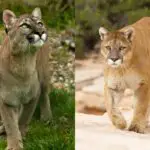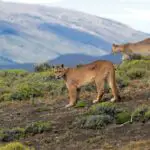Mountain lions, also known as pumas or cougars, are majestic wild cats that once roamed freely throughout North and South America. These big cats are apex predators that play a crucial role in maintaining the balance of their ecosystems. However, due to habitat loss, fragmentation, and human persecution, mountain lions are facing significant threats to their survival.
As a result, mountain lion conservation has become a critical issue for many wildlife organizations and conservationists. The conservation of mountain lions is not only essential for the survival of these magnificent animals but also for the preservation of the ecosystems they inhabit.
Mountain lions are considered an umbrella species, meaning their conservation depends on the preservation of large amounts of habitat. Therefore, protecting mountain lions can also help protect other species that share their habitat.
Mountain Lion Conservation Status
Historic Range
Mountain lions, also known as pumas, have historically ranged across North and South America, from the Canadian Yukon to the southern Andes of South America. They were once found in every state in the U.S. except for Hawaii, but their range has been greatly reduced due to hunting and habitat loss.
Current Range
Today, mountain lions are found throughout much of the western U.S., with the largest populations in California, Colorado, and Arizona. They are also found in parts of Canada and Mexico, as well as Central and South America.
Threats to Survival
Mountain lions face a number of threats to their survival, including habitat loss, fragmentation, and degradation. They are also hunted for sport and for livestock depredation control, which can lead to population declines in some areas. Additionally, mountain lions are often killed by vehicles as they attempt to cross roads.
Conservation efforts for mountain lions vary by region, but generally focus on protecting and restoring habitat, reducing conflicts with humans, and reducing poaching and illegal hunting. In the U.S., mountain lions are not currently listed as endangered under the Endangered Species Act, but some states have listed them as threatened or endangered within their borders. The International Union for Conservation of Nature (IUCN) lists mountain lions as a species of “Least Concern” globally, but notes that some populations are declining and may be at risk in certain areas.
Mountain lions are listed in Appendix II of the Convention on International Trade in Endangered Species (CITES), which means that trade in their parts and products is regulated to ensure that it is not detrimental to their survival. The U.S. Fish and Wildlife Service also monitors and regulates the hunting and trade of mountain lions within the U.S. to ensure that it is sustainable and does not threaten the species’ survival.
Habitat and Ecology
Mountain lions are large, solitary, and territorial carnivores that require a specific habitat to survive. They are found in a variety of habitats, including mountains, forests, and deserts, but they prefer rugged terrain with dense cover. Mountain lions are native to the Americas and are commonly known as cougar, puma, panther, or catamount.
Habitat Types
Mountain lions are adaptable and can survive in a wide range of habitats, from sea level to high elevations. They prefer areas with dense vegetation cover and rugged terrain that provides cover for hunting and resting. Mountain lions are found in several habitat types, including forests, grasslands, deserts, and mountains.
Diet and Hunting Behaviors
Mountain lions are carnivores and primarily feed on deer, but they also prey on other herbivores, such as guanaco. They are ambush predators and use their stealth and speed to catch their prey. Mountain lions stalk their prey until they are close enough to launch a surprise attack, which usually involves a bite to the neck that severs the spinal cord.
Adaptations and Physical Characteristics
Mountain lions have several adaptations that make them successful hunters. They have powerful legs, a flexible spine, and sharp claws that enable them to climb trees and pounce on their prey. Mountain lions have excellent vision and hearing, which helps them detect prey from a distance. They are also solitary and territorial animals that require large home ranges to survive.
In conclusion, mountain lions play a vital role in the ecosystem, and their conservation is essential. Understanding their habitat and ecology is crucial for their survival, and it is important to protect their habitat to ensure their long-term survival.
Human-Mountain Lion Conflicts
Mountain lions have been a part of the American landscape for thousands of years, but as human populations continue to grow and encroach on their habitats, conflicts between humans and mountain lions have become more frequent. These conflicts can arise in several ways, including conflicts with livestock, public safety concerns, and the need for conservation programs.
Conflicts with Livestock
Mountain lions are known to prey on livestock, such as sheep, goats, and cattle, which can lead to significant financial losses for ranchers. To address this issue, some ranchers have implemented measures such as using guard dogs, electric fencing, and removing attractants such as carcasses. However, these measures are not always effective and can be costly.
Public Safety and Precautions
While mountain lion attacks on humans are rare, they can be deadly. To reduce the risk of attacks, it is important for people to take precautions when in mountain lion habitats, such as avoiding hiking or jogging alone, keeping children and pets close, and making noise to alert mountain lions of your presence. In addition, it is important for communities to have plans in place for responding to mountain lion sightings or attacks.
Conservation Programs
Conservation programs play a key role in reducing human-mountain lion conflicts. The Mountain Lion Foundation, for example, works to protect mountain lions and their habitats through research, education, and advocacy. Other programs focus on promoting coexistence between humans and mountain lions, such as the Living with Lions program in Colorado, which provides resources and information to help people reduce the risk of conflicts with mountain lions.
In conclusion, human-mountain lion conflicts are a complex issue that requires a multi-faceted approach. By implementing measures to protect livestock, taking precautions to reduce the risk of attacks, and supporting conservation programs, we can work towards reducing these conflicts and promoting coexistence between humans and mountain lions.
Conservation Efforts
Conservation efforts for mountain lions have been ongoing for several years. These efforts are aimed at preserving the species, protecting their habitats, and ensuring that they thrive in the wild. Here are some of the conservation efforts that have been implemented:
Endangered Species Act
The Endangered Species Act (ESA) is a federal law that provides protection to endangered and threatened species and their habitats. In 1990, the mountain lion was listed as a “sensitive species” under the ESA in California. This designation means that the species is not currently threatened or endangered, but it could become so in the future. The ESA has been instrumental in protecting the mountain lion’s habitat from development and other activities that could lead to habitat destruction and fragmentation.
Breeding and Preservation Programs
Breeding and preservation programs have been implemented to help increase the mountain lion population. These programs involve breeding mountain lions in captivity and releasing them into the wild. The goal of these programs is to increase the genetic diversity of the population and to ensure that the species continues to thrive.
Critical Habitat and Corridors
Critical habitat and corridors have been identified to ensure that mountain lions have the necessary space to roam and hunt. These areas are protected from development and other activities that could lead to habitat destruction and fragmentation. Corridors are also important for dispersal, allowing mountain lions to move between different habitats and populations.
Conservation efforts are supported by scientific research and communication. Scientists study the mountain lion’s behavior, population, and habitat to better understand how to protect the species. Communication is also important to help educate the public about the importance of protecting mountain lions and their habitats.
In conclusion, conservation efforts for mountain lions are ongoing and involve a variety of strategies, including protection under the ESA, breeding and preservation programs, identifying critical habitat and corridors, and scientific research and communication. These efforts are essential to ensure that the mountain lion continues to thrive in the wild and remains a keystone species in its ecosystem.
Regional Conservation Efforts
Mountain lions, also known as puma concolor, are an important species in the ecosystems they inhabit. Their conservation is crucial to maintain a balanced ecosystem. Efforts to conserve mountain lions are underway in different regions where they are found.
California
California is home to a significant population of mountain lions, and conservation efforts are being made to protect them. In Southern California, the National Geographic Society’s Remote Imaging Project is monitoring mountain lions using remote cameras. This project is helping to identify the population size and migration patterns of these big cats.
Florida
The Florida panther is a subspecies of mountain lion that is found in the southern part of the state. Due to habitat loss and hunting, the Florida panther was almost extinct in the 1970s. However, conservation efforts, including habitat restoration and captive breeding programs, have helped increase the population.
Utah
In Utah, mountain lions are protected under the state’s Wildlife Resources Code. The Utah Division of Wildlife Resources is working to monitor and manage the state’s mountain lion population. The division is also working to educate the public about the importance of these big cats in the ecosystem.
Southern Chile
The mountain lion population in Southern Chile is isolated from other populations in South America. Conservation efforts are being made to protect this population, which is threatened by habitat loss and poaching. The Tompkins Conservation Foundation is working to create a wildlife corridor to connect the isolated population to other populations in the region.
In conclusion, conservation efforts are being made in different regions worldwide to protect the mountain lion population. These efforts are essential to maintain the balance of the ecosystem and ensure the survival of this majestic species.
- Sink Your Teeth Into This: Analyzing the Powerful Lion Bite Force - September 8, 2023
- Siberian Tigers: Everything You Need To Know - September 4, 2023
- Do Lions Eat Humans? Understanding Lion Aggression and Risks - September 4, 2023







